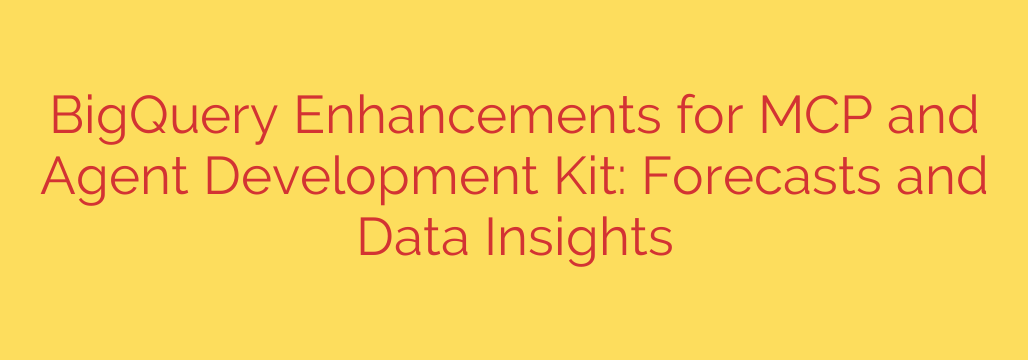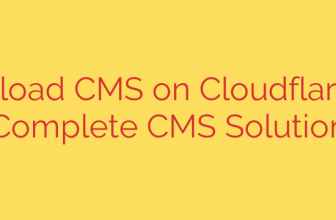
Unlock Predictive Power: Leveraging New BigQuery Enhancements for Advanced Forecasting and Insights
Making accurate predictions from vast datasets has long been the domain of specialized data scientists and complex machine learning pipelines. For many organizations, the ability to forecast future trends—be it sales, user activity, or system load—remained just out of reach due to technical complexity. However, recent advancements are democratizing this powerful capability, bringing predictive analytics directly into the data warehouse.
Powerful new enhancements now integrate advanced forecasting and analysis tools directly within the Google BigQuery environment. This development is a game-changer for developers and data analysts, allowing them to generate valuable predictions and uncover deep insights using familiar SQL commands.
The Power of Integrated Time-Series Forecasting
Traditionally, creating a forecast model required exporting data from your warehouse, feeding it into a separate machine learning framework, training a model, and then importing the results. This process is not only time-consuming but also creates data silos and adds unnecessary complexity to your workflow.
The latest updates streamline this entire process. You can now build, train, and deploy sophisticated time-series forecasting models directly within BigQuery using BigQuery ML (BQML). This means you can stay within a single environment to predict future values based on historical data, dramatically reducing both development time and the barrier to entry for predictive analytics.
This integration is especially powerful for anyone working with an Agent Development Kit or a centralized management platform, as it allows for the seamless analysis of telemetry, performance metrics, and log data.
How It Works: Simplified Machine Learning with SQL
The beauty of this enhancement lies in its simplicity. Instead of writing hundreds of lines of Python code, you can leverage the power of SQL to create powerful models.
The core of this functionality revolves around the CREATE MODEL statement in BigQuery ML. With a simple query, you can specify your time-series data, define the timestamp and data columns, and instruct BigQuery to automatically create a forecasting model.
Key benefits of this SQL-based approach include:
- Accessibility: Teams already skilled in SQL can immediately start building predictive models without needing to learn new programming languages or frameworks.
- Speed: Models are trained on Google’s powerful infrastructure, delivering results much faster than on local machines.
- Automation: BigQuery ML automates many of the complex steps in model creation, such as feature engineering and hyperparameter tuning, making it easier to get accurate results.
Once a model is trained, you can use the ML.FORECAST function to generate predictions for a future period. The output provides the predicted value, along with a confidence interval, giving you a clear and actionable understanding of the likely future trend.
Beyond Forecasting: Uncovering Deeper Data Insights
While forecasting is a major component, these new tools also empower deeper, more immediate data analysis. By applying machine learning models to your datasets, you can uncover hidden patterns, identify anomalies, and understand the key drivers behind your data points.
For example, you can analyze application performance logs to not only forecast future server load but also to automatically detect unusual spikes in error rates that could indicate a system failure or a security event. This moves your team from a reactive to a proactive stance.
Practical Applications and Security Tips
The applications for integrated analytics are vast and impactful. Here are a few ways your organization can leverage these capabilities:
- Business Intelligence: Forecast product sales for the next quarter, predict customer churn, or estimate future demand to optimize inventory management.
- Operations: Predict website traffic to scale server resources efficiently, or forecast energy consumption in a data center to reduce costs.
- Security Analysis: This is a particularly critical use case. By creating a model of normal network behavior or user activity, you can use forecasting to proactively identify security threats. When real-time activity deviates significantly from the forecasted “normal” range, an alert can be triggered for immediate investigation. This is a powerful technique for detecting zero-day exploits or insider threats that might bypass traditional signature-based security tools.
To get started, ensure your data is clean and well-structured, particularly your time-series data, which should have consistent intervals. Begin with a clear question you want to answer, such as “What will our user sign-ups be for the next 30 days?” This will help you select the right data and build a more effective model.
By bringing forecasting and machine learning directly into the data warehouse, these BigQuery enhancements are breaking down barriers and empowering more users than ever to make data-driven decisions with confidence.
Source: https://cloud.google.com/blog/products/data-analytics/ai-based-forecasting-and-analytics-in-bigquery-via-mcp-and-adk/








